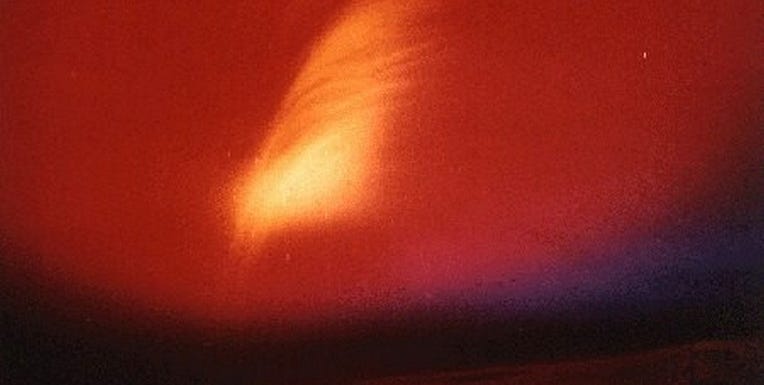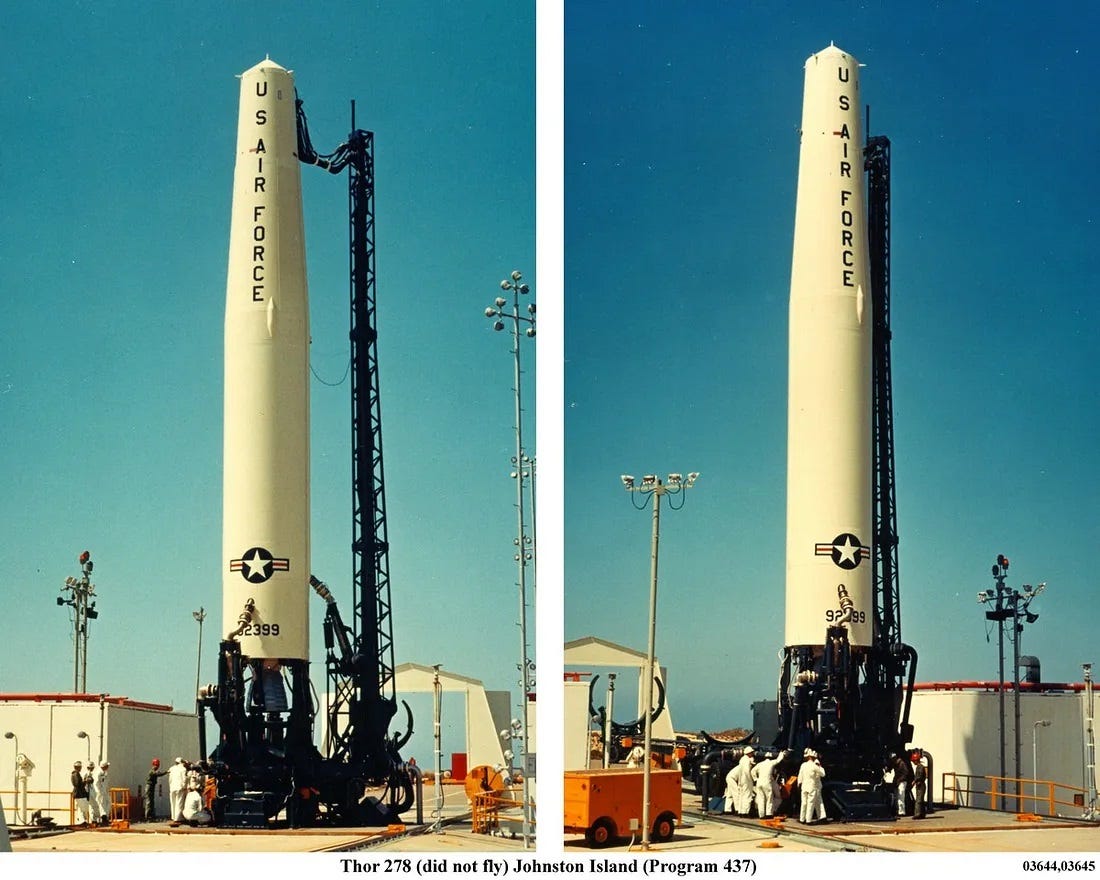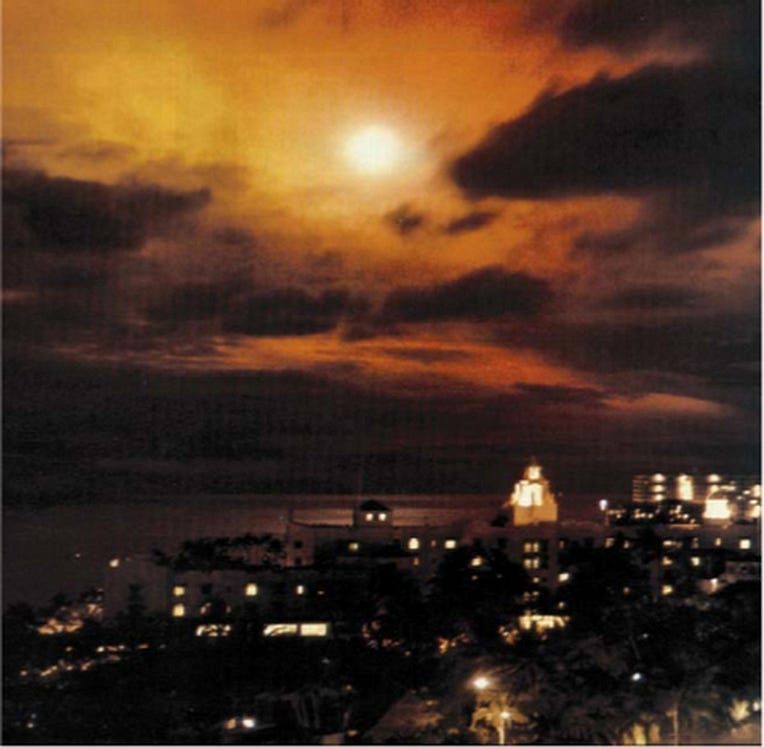by SEBASTIEN ROBLIN
On March 27, 2019 a modified ballistic missile on a launch pad in Chandipur, India rocketed 176 miles into space to destroy a Microsat-R satellite, shattering it into more than 400 fragments.
The test made India the fourth state after United States, Soviet Union and China to have destroyed a satellite in orbit.
International observers warned, however, that the resulting debris could remain in orbit for more than a year, posing a risk to satellites the world relies on for navigation, scientific research, communications and other vital functions.
In fact, anti-satellite weapons demonstrated from the very beginning they could make a tremendous mess. That’s because the first anti-satellite missiles ever operationally deployed by the United States relied on nuclear warheads—this after a huge nuclear test detonated in space fried one-third of all orbiting satellites.
Orbital missiles
The Pentagon first floated the concept of anti-satellite weapons in April 1954, three years before any human-made satellites had been launched into space.
Scientists noted that nuclear-tipped ballistic missiles designed to arc into space—and counter-missiles designed to stop them—could be modified to blast orbital targets. While the precision guidance necessary to directly hit a satellite was technically challenging, using a nuclear warhead could considerably reduce the margin of error.
As the 1950s-era Pentagon assumed nuclear weapons would be liberally employed in future wars, it slapped nukes on everything from air-to-air missiles to artillery shells, bazooka-like Davy Crockett recoilless guns, depth charges, land mines and anti-submarine torpedoes.
Scientist Nicholas Christofilos also hypothesized that high-energy electrons emitted by nuclear blasts would have destructive secondary effects beyond the blast itself.
In 1958 the United States conducted a series of high-altitude nuclear tests that exhibited phenomena such as electromagnetic pulses that disrupted nearby electronics and lingering electron clouds which supported Christofilos’s conjectures.
The Pentagon therefore sought larger-yield tests to see if these effects could be weaponized against space-based assets—and also determine how nuclear blasts might disrupt radio communications and electronics for troops on the ground.
But whose job should it be to swat any future Soviet satellites—the Army or Air Force? The branches operated rival missiles systems that could be adapted for anti-satellite missions.
Even the Navy joined in and proposing to convert Polaris submarine-launched ballistic missiles for anti-satellite purposes in a program known as “Early Spring.”
The submarine-launched missile was controlled via data-link, and would home in on a satellite using an optical sensor to detonate a proximity warhead made of thousands of steel pellets.
The Air Force attempted the first ever anti-satellite weapons test on Sept. 22, 1959 when a B-58 bomber traveling at twice the speed of sound fired an air-launched ballistic missile at the Explorer 4 satellite.
However, testers lost contact with the missile less than a minute after its launch.
Three weeks later in Operation Bold Orion on Oct. 13, 1959, a B-47 bomber launched a modified WS-199B missile that passed within four miles of the targeted Explorer 5 satellite orbiting 176 miles over the Earth’s surface. This counted as a hit, as a nuclear blast at that distance would have sufficed to knock out the satellite.
In Operation High-Hoe, the Navy twice in 1962 tested air-launched ASATs from an F-4B fighter.
Ironically, despite nominally claiming the lead in the space race with the launch of Sputnik in October 1957, it took the Soviet Union years to deploy the reconnaissance satellites the anti-satellite weapons were designed to destroy.
The concern motivating developments of ASATs were hypothetical Fractional Orbital Bombardment System—weapons platforms in partial low-earth orbit that could rain nuclear warheads from space.
In fact, the Pentagon assessed that FOBSs did not pose a major threat—not because they were technically impossible, but because land-based intercontinental-ballistic missiles could achieve the same outcome more cost-efficiently and reliably. Still some strategist felt that developing even a minimal anti-satellite capability might dissuade the Soviets from developing FOBSs.
However, Pres. Dwight Eisenhower feared that the nuclear tests and space-based weapons programs would simply spur a space arms race. Therefore, he discontinued the high-altitude detonations and put the brakes on ASAT development near the end of his presidency.

Set the sky on fire
In September and October 1961, the Soviet Union began a series of new nuclear tests including detonation of the 50-megaton Tsar Bomba, the largest nuke ever tested, and four low-yield high-altitude detonations.
The United States in 1962 retaliated with Operation Dominic, a series of 31 nuclear tests in the Pacific. Though most involved gravity bombs dropped by B-52 bombers, there were also eight attempted high-altitude detonations between June and November 1962 involving Air Force PGM-17 Thor intermediate-range ballistic missiles launched from Johnston Island, 800 miles southwest of Hawaii.
The first two tests, Bluegill and Starfish, went poorly. On June 2, 1962, the launch site lost its radar track of the Bluegill rocket shortly after launch, and thus remotely destroyed the missile.
The first Starfish launch on June 19 the same year began breaking apart 59 seconds after launch. An operator self-destructed the missile at 35,000 feet, showering the island and surrounding waters with plutonium-contaminated fragments.
Finally, at 10:00 P.M. on July 9, 1962 the Johnston site successfully launched a Thor missiles 250 miles into space for operation Starfish Prime. Thirteen minutes later, T-0 detonated its 1.4-megaton-yield W49 warhead.
The blossoming sphere of greenish fire could be seen hundreds of miles away in Hawaii—and its electromagnetic pulse knocked out lights and telecommunication links across the archipelago.
Moreover, the burst of high-energy electrons emitted by the detonation created an artificial glowing purplish-red aurora that lingered for days in the sky. Hawaiian hoteliers even hosted rooftop rainbow bomb parties.
The resulting radiation belt drifted into higher orbit, wreaking havoc on the fledgling satellite infrastructure of the time with radiation levels 100 to 1,000 times higher than normal.
The Navy’s TRAAC satellite used to monitor radiation for the test suffered solar-cell damage and ceased transmitting 36 days later.
So did the Transit 4B satellite used for navigation by submarines carrying Polaris ballistic missiles. It became non-functional on Aug. 2, 1962. Ariel 1, the first operational British satellite, lost 25 percent of its solar-panel capacity and had its telemetry corrupted.
The day after Starfish Prime, the British Telstar 1 launched into space, establishing the first trans-Atlantic television and telephone satellite-relay. But just two months later one of its command decoders broke down, burned out by radiation. Though eventually restored to partial functionality, Telstar 1 broke down entirely in February 1963, its transistors ionized.
Four more satellites suffered damage, including the secret Explorer 14 and 15 intelligence satellites. This meant the nuclear test had destroyed or damaged one third of the 24 satellites in orbit at the time.
The EMP pulse and orbital damage led the U.S. to cancel further high-yield test detonations, but five high-altitude tests proceeded using lower-yield nukes.
The Thor rocket involved in Bluegill Prime on July 25, 1962 erupted in a fiery conflagration on the launch pad and had to be self-destructed, contaminating the island a second time.
The following rocket made it into the sky only to begin tumbling back down after a booster failure, and it too was self-destructed.
Finally, three more Thor launches proceeded successfully between Oct. 26 and Nov. 2, 1962. The following year, the Nuclear Test Ban Treaty brought an end to high-altitude nuclear tests.
But the Pentagon was now satisfied that nukes could be made into a potent anti-satellite.
Project 505
By 1962 the U.S. Army had developed the Nike-Zeus anti-ballistic missile system, based on the Kwajalein atoll in the Pacific Ocean. Its DM-15B interceptors had a limited capability to swat ballistic missiles plunging down from space using a 400-kiloton W50 warhead.
In May 1962, Defense Secretary Robert McNamara approved Operation Mudfalp to adapt the Nike-Zeus ABM with modified DM-15S missiles developed to hit higher-flying satellites. The DM-15S featured improved battery life, fuel and maneuverability.
Because Nike-Zeus’s used solid-fuel, it could be fired on very short notice instead of requiring hours to pump full of liquid fuel. Civilian personnel from the Bell telephone company operated the complicated system.
The first Nike-Zeus anti-satellite missile launched on March 21, 1963 failed to lock on target. The tracking beacon on the second, launched April 19, 1963 failed a half minute prior to detonation. Finally, on May 24, 1963 a DM-15S managed to hit an Agena-D satellite bus in orbit.
The following month, McNamara ordered the Project 505 system put on operational status, pleased to have the capability to order the destruction of a Soviet satellite “with a phone call.”
However, just a year later funding for Project 505 was reduced, and the program ended in 1967.
McNamara had decided it was time to end the Army-Air Force rivalry over long-range ballistic missile and space capabilities. These became the Air Force’s exclusive purview.
Besides, Nike-Zeus could only hit satellites in low Earth orbit, with a maximum altitude of 175 miles and maximum range of 250 miles. The Air Force by 1967 had developed a more capable ASAT weapon.

Thor’s rise
The Thor missiles the Air Force fired in the Dominic tests featured a 1,700-mile range, a maximum altitude of 700 miles and the ability to carry higher-yield warheads, making them far more flexible anti-satellite weapons. Though Thor missiles required more lead time to launch, both systems required hours to detect targets and compute intercepts anyway.
In March 1963, McNamara gave the Air Force funding to standup the 10th Aerospace Defense Squadron at the Johnston Island launch site. The unit would keep two pads on alert to launch anti-satellite attacks, supplied with spare Thor missiles with backups rocket boosters stored in Vandenberg, California. Most of the unit’s 178 personnel were rotated to the island on 90-day shifts.
The 10th’s crews could plot an intercept with six to 12 hours of lead time using a computer algorithm developed by the Ford motor company—with launch windows no longer than five seconds!
The Thor ASATs were accurate within three miles of a linear target, while their nuclear warheads could knock out satellites within five miles, with an estimated 70-pecent probability of kill.
In 1964, three of four test launches resulted in successful intercepts of orbiting targets, though the last failed due to a defective rocket booster. Thus, the Air Force declared Program 437 Initial Operations Capable, with two nuclear-tipped ASAT missiles placed on 24-hour alert.
That September, Pres. Lyndon Johnson revealed the anti-satellite unit’s existence to the public—though to what extent the message was aimed at the Soviets, versus the U.S. electorate, remains debatable.
The Defense Department had qualms, however, about blowing up Soviet satellites without confirming they actually presented a kinetic threat. Thus, in December 1965, Program 437 began testing “Advanced Payload” missiles designed to inspect potentially hostile satellites by snapping high-resolution photographs of them.
These were dropped back into the atmosphere over Hawaii in a reentry canister recovered mid-freefall by a specially modified C-130 transport plane.
The 437AP worked in tests, and the Air Force even planned launching one to inspect a Soviet satellite in 1966. However, the Joint Chief of Staff vetoed the mission, fearing it would prove to provocative. As maintaining the inspection missiles left only one ASAT available to launch for kinetic attacks, the Pentagon canceled 437AP that November.
By then, the Defense Department was shifting funding away from strategic weapons to fighting the Vietnam War—even though the Soviet Union did begin deploying semi-orbital nuclear weapons.
Program 437 increasing lacked funding to test launches and was stripped of much of its security staff. Tropical storms and humidity at the remote island outpost caused the sensitive rockets to deteriorate. And the Air Force was also running out of the out-of-production Thor boosters.
By the late 1960s, the Defense Department grew increasingly disenchanted with its ASAT efforts. Program 437 had very limited capability. It required long lead times to execute an attack. Its radar couldn’t detect satellites approaching from certain latitudes.
The Thor ASATs could not hope to engage more than a few targets. Their remote island base was vulnerable to attack by submarine.
Finally, using nuclear weapons to blow up space satellites could easily be misinterpreted as part of preemptive nuclear strike, risking extensive and unpredictable damage to friendly satellites providing vital intelligence and communication capabilities.
By the 1970s, Program 437 was on life support—barely funded to maintain the facility in case the military changed its mind. The nuclear warheads were not deployed on the missiles and the necessary lead time for a strike grew to 30 days.
Finally, on Aug. 19, 1972 Hurricane Celeste trashed the Thor launch pads and the guidance computers the ASATs depended upon. Though the site was eventually restored to partial functionality, the program’s fate was sealed, and it closed for good in March 1975.
Such were the Defense Department’s topsy-turvy priorities that it recommenced developing new anti-satellite weapons less than two years later, culminating in the 1980s in the ASM-135 anti-satellite missile, which launched from an F-15 fighter.
However, the days of nuclear anti-satellite missiles that would make the sky glow with radioactive auroras were over—hopefully, for good.
Sources
“Collateral Damage to Satellites from EMP Attack,” by Edward Conrad et al, Defense Threat Reduction Agency
“History of U.S. Anti-Satellite Weapons,” by Federation of American Scientists
“Shooting Down a Star: Program 437, the U.S. Nuclear ASAT System, and Copycat Killers,” by Clayton Chun







